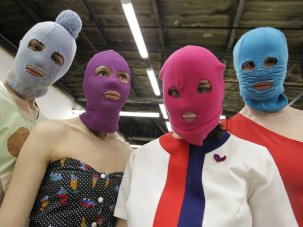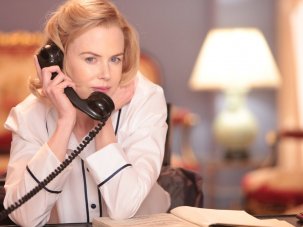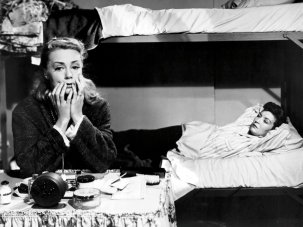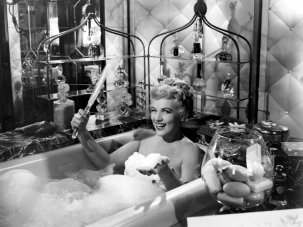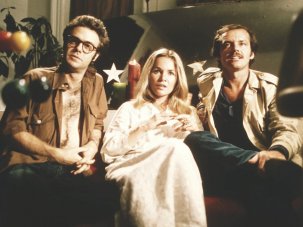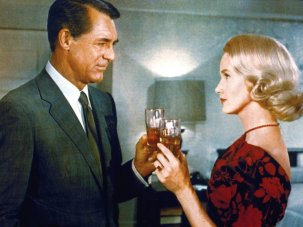Web exclusive
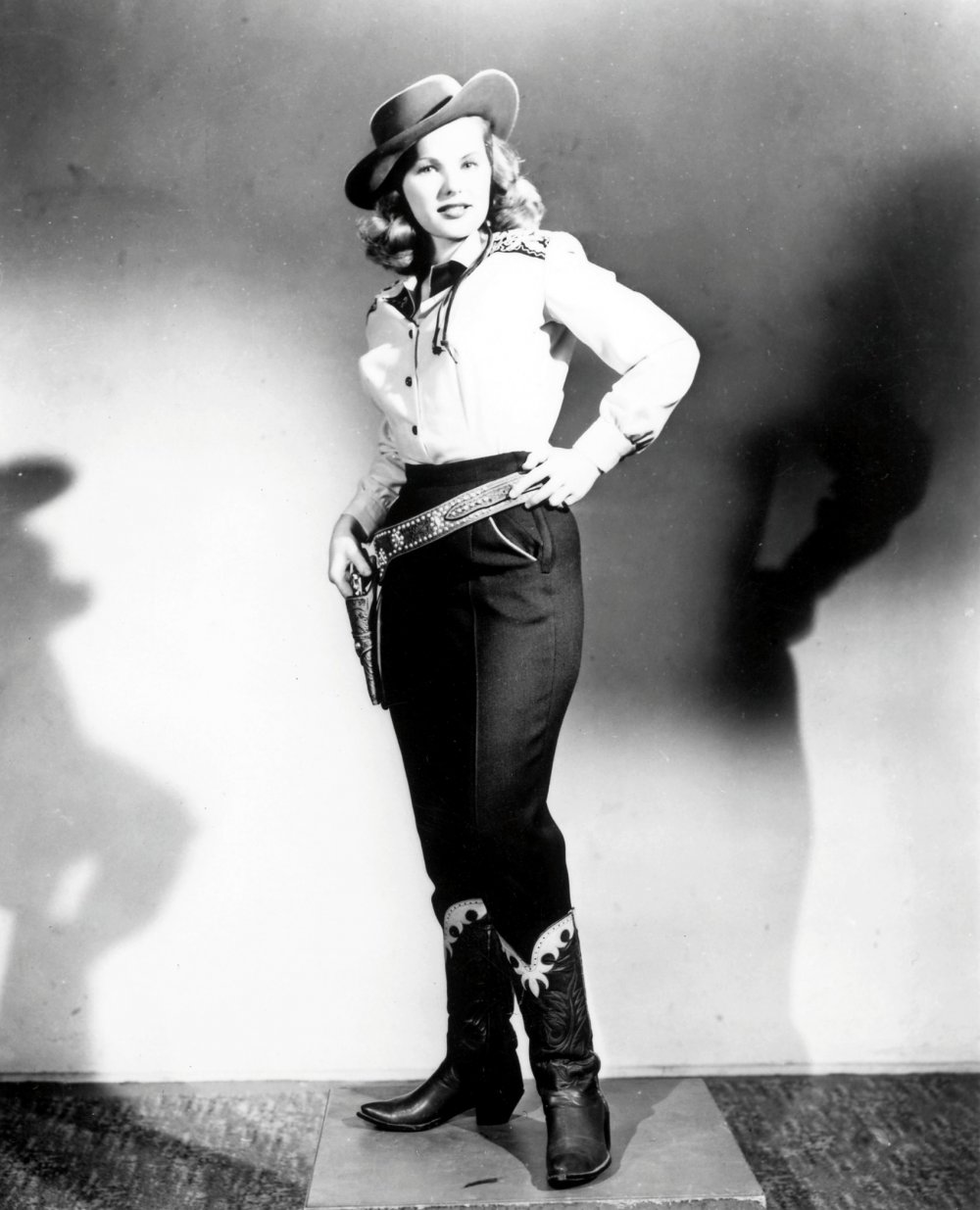
American outlaw: Peggy Cummins in a publicity shot for Gun Crazy (1949)
Approximately half-way through Joseph H. Lewis’s Gun Crazy (1949), Annie Laurie Starr (Peggy Cummins) enters her workplace in a smart pair of black trousers.
“May I ask why you’re wearing slacks?” asks the horrified office manager, Miss Sifert (Anne O’Neal). “That’s all I had today. My dry cleaning didn’t come back,” replies Annie meekly. Miss Sifert’s response is delivered almost contemptuously: “I’ll expect you tomorrow in a skirt.”
But tomorrow will never come for Miss Sifert. A few minutes after issuing her reprimand, she is shot dead by Annie, who took a job with this company purely so she could rob it, and presumably wore trousers on this particular day because they would be easier to run in after the heist.
One could hardly ask for a neater encapsulation of those male fears addressed by images of women in trousers. A few years earlier, women had enjoyed unprecedented autonomy, donning masculine clothes to work in factories while their husbands were away fighting World War II. When the men returned, these women were expected to resume their former roles as dutiful housewives. Yet the suspicion remained that this liberated feminine genie might not return so willingly to its bottle, and if women in trousers had been seen as appealingly sexual during the 30s (Marlene Dietrich in Morocco, for example), in the postwar period they come across as threatening, implicitly challenging patriarchal control.
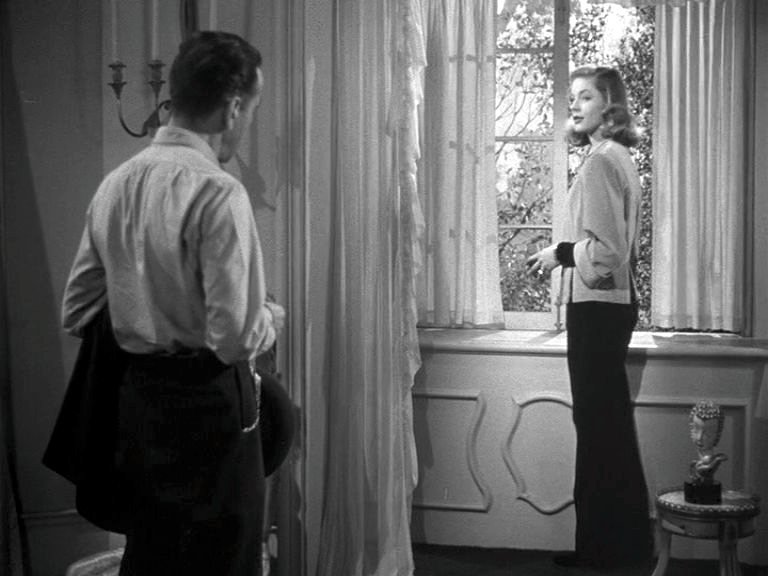
Lauren Bacall asks the questions in The Big Sleep (1946)
The noir genre, with its emphasis on femme fatales and disturbed ex-servicemen, provides numerous examples of men troubled by newly masculinised women.
In Raymond Chandler’s 1939 novel The Big Sleep, Vivian Rutledge is initially viewed through the eyes of narrator Philip Marlowe, who boasts, “I stared at her legs in the sheerest silk stockings.” In Howard Hawks’s cinematic adaptation, however, Vivian, as played by Lauren Bacall, is introduced wearing trousers, her nonchalant pose depriving Marlowe/Humphrey Bogart of the right to dominate their conversation. But when Vivian visits Marlowe’s office, she is wearing a skirt suit, her self-assurance being undermined by these feminine clothes; she nervously rubs her stockinged knee, then, at Marlowe’s prompting, lifts the skirt’s hem and scratches her leg.
Similarly, the ‘good’ blonde Eve Geddes (Nan Leslie) in Jean Renoir’s The Woman on the Beach (1947) is first seen in overalls as she cuts a piece of wood – prompting her fiancé, traumatised veteran Scott Burnett (Robert Ryan), to point out that she’ll have to put on a dress if she wants to get married. Yet ‘bad’ brunette Peggy Butler (Joan Bennett) is also introduced wearing trousers and engaged in an activity involving wood (she is gathering firewood). The implied connection between these women enables Renoir to expose those assumptions upon which the good girl/bad girl opposition is based; the film ends with Eve (last seen asking Scott if he likes her dress) forgotten and Peggy redeemed.
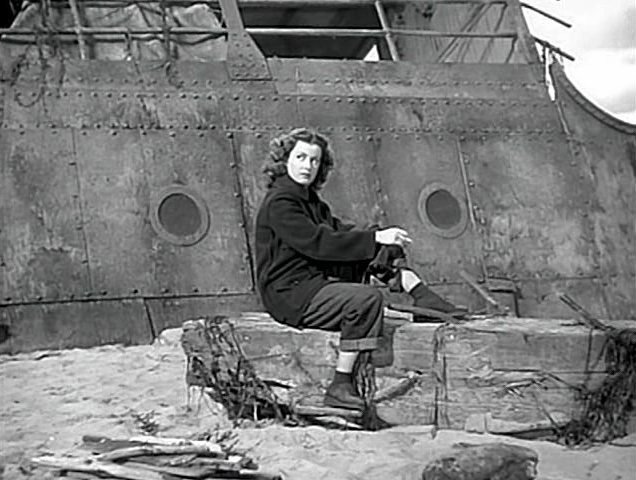
Joan Bennett’s undomesticated Peggy in The Woman on the Beach (1947)
Negative attitudes towards women in trousers can also be found in other genres. In Otto Preminger’s courtroom melodrama Anatomy of a Murder (1959), Paul Biegler (James Stewart) orders trouser-wearing good-time girl Laura Manion (Lee Remick) to put on a skirt and a girdle. When Laura, once again dressed in trousers, hands Biegler her girdle as a souvenir after the trial, he suggests she keep it, since she “might need it again some time.”
If women’s trousers here suggest uncontrollable sexuality, in 50s science fiction they imply precisely the opposite: an intellectuality imbricated with frigidity. Like many entries in this cycle (notably Hawks’s The Thing from Another World), Gordon Douglas’s Them! (1954) links its scientists with the non-human menace. Before glimpsing Dr. Patricia Medford (Joan Weldon)’s face, we see her legs as she descends from an aircraft, her skirt becoming momentarily caught on a ladder.
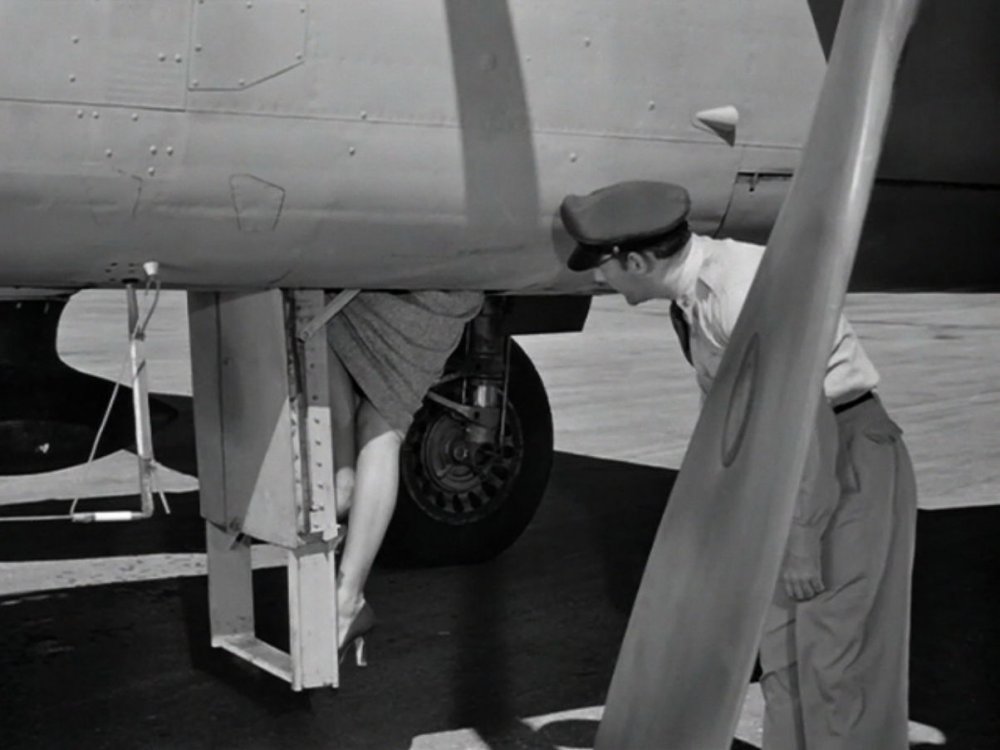
Joan Weldon as another Other in Them! (1954)
Aside from defining Dr. Medford as an object for the male gaze, this image suggests that, in her impractical feminine costume, she is as much of a mysterious ‘other’ as the giant ants whose mystery she has arrived to investigate. Yet when Dr. Medford changes into masculine overalls before entering the ants’ nest, her clothing is still perceived as problematic; FBI agent Robert Graham (James Arness) asks what she is “made up for” and insists the nest is “no place for you or any other woman”. Graham is clearly wrong about this, since the most significant threat is represented by the queen ant, and the film’s emphasis on fears of masculine redundancy is reinforced by Dr. Harold Medford’s lecture, in which he points out that male ants die after mating.
Aside from the musical (which, with its utopian visions of gender equality, is a special case), the western – focusing as it does on pragmatic measures taken by individuals fighting to civilise a savage wilderness – is perhaps the only genre in which trousered women tend to be viewed positively. Indeed, the jeans-wearing female westerner usually makes for a favourable contrast with her ideological opponent, the elaborately dressed woman from the east.
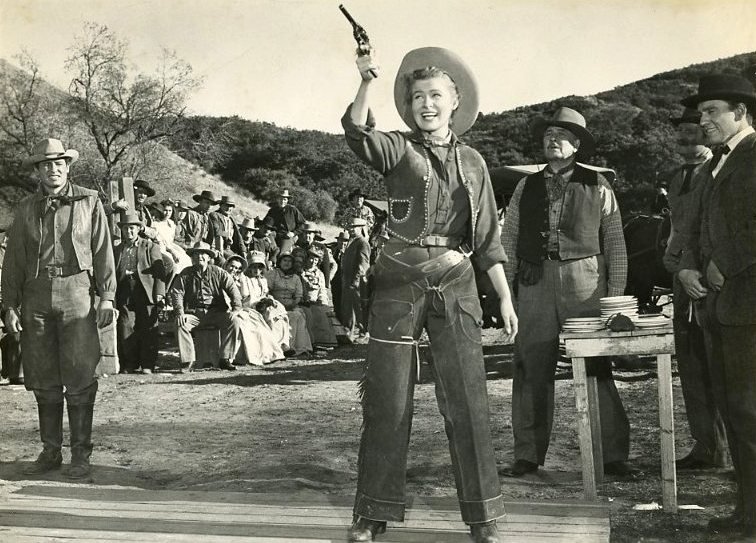
Dressed as she pleases: Nancy Olson in The Boy from Oklahoma (1953)
But even here contemporary concerns occasionally find a voice. When Ruth Hood (Beverly Garland) takes over her dead husband’s job as marshall in Roger Corman’s Gunslinger (1956), her deputy points out that “some people won’t think it’s proper for a new widow to go around in pants, even though they are black,” while in Michael Curtiz’s The Boy from Oklahoma (1953), sheriff Tom Brewster (Will Rogers Jr.) informs Katie Brannigan (Nancy Olson) that “it’s against the law for a female to be wearing men’s pants in public.” When Katie consults a law book and discovers “There’s nothing in here about women not being able to dress as they please,” Brannigan responds, “I didn’t say it was a law in this town. But where I come from it is. Folks there got sense. They want some quick way of telling their women apart from their men… How do you think I’d look in a skirt?”
This question is echoed in David Butler’s Calamity Jane (1953), which uses men in drag as a source of humour. Calamity/Doris Day’s male attire, on the other hand, is identified with energies of which the film ambiguously approves, but also suggests a pre-sexual immaturity that must be transcended.
In Nicholas Ray’s noir-tinged Johnny Guitar (1954), Vienna (Joan Crawford) is initially seen wearing black trousers which signify her usurpation of the masculine role; as one of her male employees complains, “I’ve never seen a woman who was more a man. She thinks like one, acts like one, and sometimes makes me feel like I’m not.”
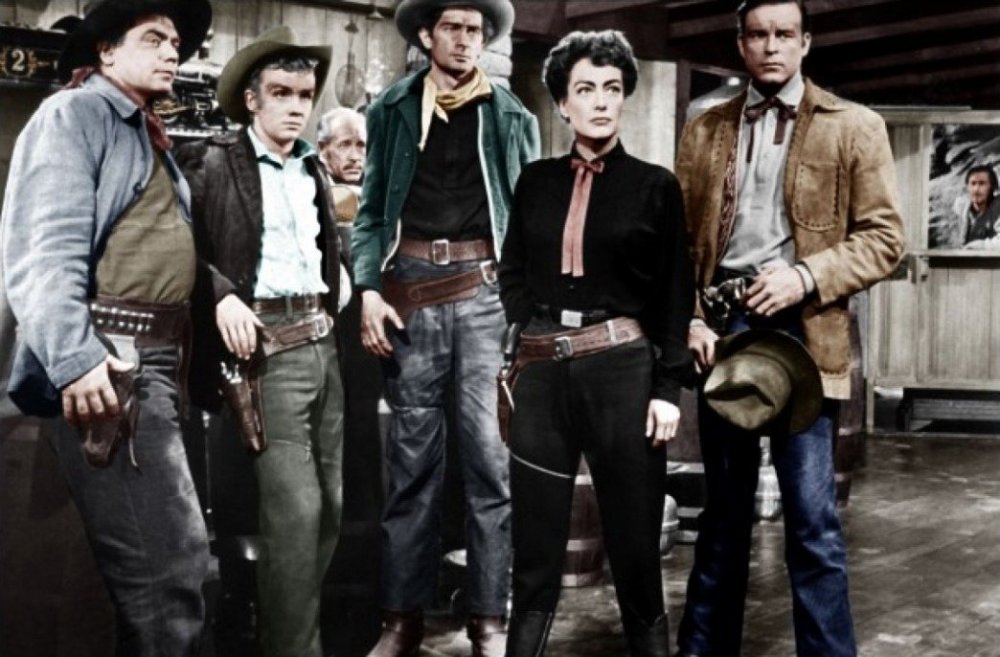
Joan Crawford on top in Johnny Guitar (1954)
But Vienna subsequently adopts elaborately feminine outfits, only resuming masculine garb for practical reasons and under male direction: she takes off her white dress and puts on jeans at Johnny Guitar’s bidding (“Taking you out of here in that dress is like carrying a lantern”), then, after swimming across a river, removes her wet clothes and changes into trousers formerly owned by Turkey (a male character defined in terms of masculine inadequacy) at The Dancing Kid’s suggestion.
During the early 1980s, discouraging women from wearing masculine clothes made an unexpected comeback as part of Ronald Reagan’s return to ‘the good old days’ of American imperialism. Compare Steven Spielberg’s unambiguously reactionary Raiders of the Lost Ark (1981) with Costa-Gavras’s Missing (1981), which subjects imperialism to extensive criticism. In Raiders, Marion Ravenwood (Karen Allen) is introduced as an independent businesswoman in trousers, fully capable of drinking men under the table and punching Indiana Jones (Harrison Ford); but once she has been persuaded to put on a dress (in a sequence Spielberg will repeat, to quite different effect, in Always), she becomes an absurd damsel in distress who needs to be rescued.
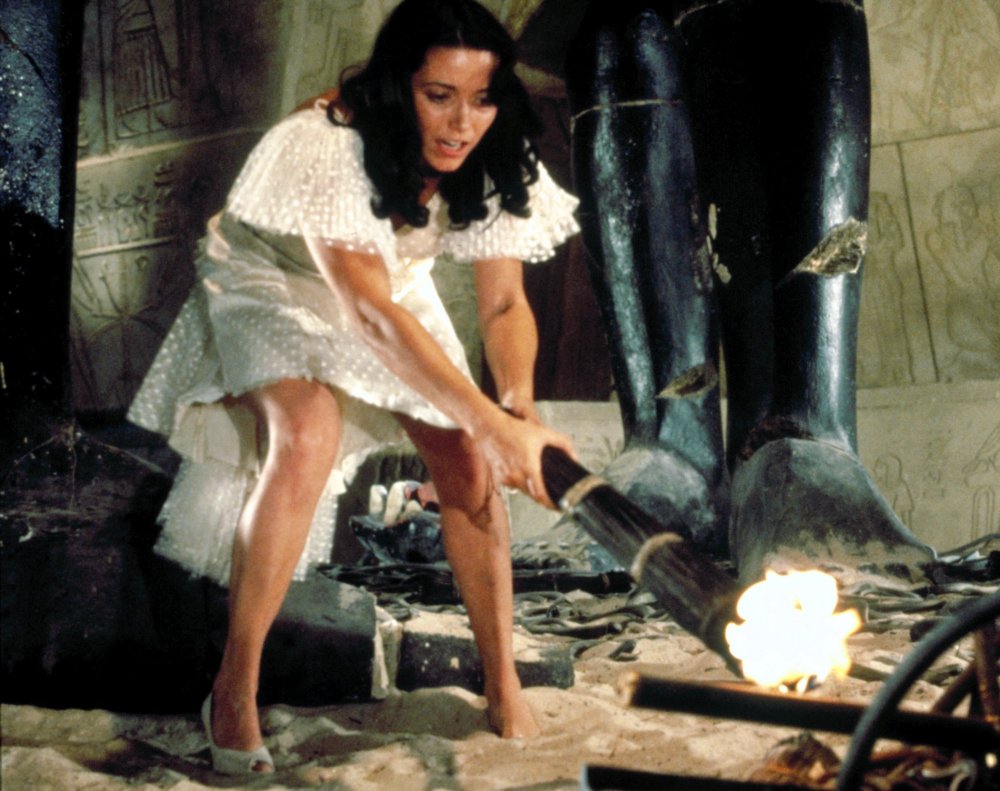
Karen Allen in distress in Raiders of the Lost Ark (1981)
The precise nature of Spielberg’s misogyny is neatly exposed by a scene in Missing which shows soldiers roughly pulling two trousered females out of the line at a bus stop, informing them that “From now on, women in this country wear dresses,” and cutting off their trousers with a knife. Such treatment was apparently commonplace in Pinochet’s Chile – Isabel Allende mentions it in The House of the Spirits – and similar incidents occur even today; journalist Lubna Hussein was one of several women arrested and sentenced to a flogging for the crime of wearing trousers in Sudan.
I had these events in mind while writing my novels The Hunt and A Caution to Rattlesnakes, which take place in a dystopian future where women have been stripped of all rights and are required by law to wear skirts.
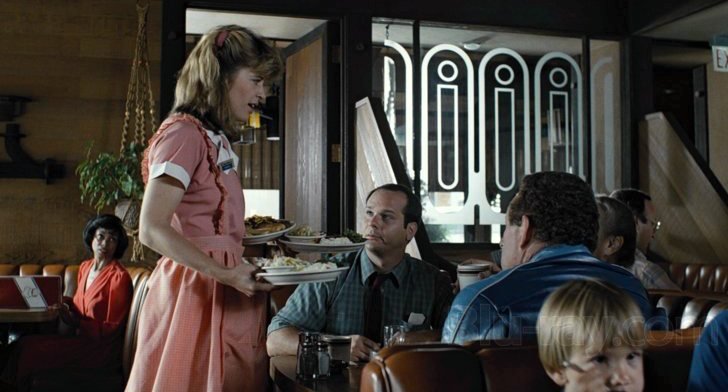
Linda Hamilton by day in The Terminator (1984)
This may currently be the stuff of science fiction, but it seems to me the logical extension of that ideologically loaded state of affairs we generally accept as ‘normality’. While gradually becoming more acceptable for women, trousers have never quite lost their connotations of displaced masculinity (Hillary Clinton is regularly mocked for wearing them), a masculinity which, though it may be desirable and attractive, nonetheless exists in a world rigorously separated from that of the everyday.
Just as the virile westerner was opposed to the domesticated male of small-town melodrama, so the liberatingly trousered action heroines of the Alien, Terminator, Hunger Games, Underworld and Matrix franchises have their echoes in the compulsorily skirted protagonists of post-60s films that address the realities of women’s working lives: Working Girl’s Tess McGill (Melanie Griffith), who, upon arriving at her office, replaces her running shoes with high heels; or Claire Fisher (Lauren Ambrose) in a Mary Harron-directed episode of Six Feet Under (2005), appalled to discover that the dress code of the corporation she’s temping for obliges her to wear pantyhose (“Doesn’t it seem sexist,” she asks a fellow worker, “that it’s a regulation only for women?”); even The Terminator’s Sarah Connor (Linda Hamilton) is introduced changing out of the jeans in which she arrives (by motorcycle) at the restaurant where she works, and into the stereotypically feminine pink dress that appears to be mandatory for female employees.

Nicole Kidman encumbered in The Invasion
Yet modern SF films frequently reverse this motif. The Invasion’s protagonist, lawyer Carol Bennett (Nicole Kidman), is seen in ‘professional’ skirts and tights until the need to move rapidly while being pursued by bodysnatching aliens compels her to discard these restricting garments and, after ritualistically washing her face, put on a pair of jeans. Divergent’s Tris (Shailene Woodley) exchanges the grey-uniform dress required by ‘Abnegation’ – the contemplative faction in which she has been raised – for trousers when she joins the action-oriented ‘Dauntless’, subsequently burning the dress in a ritualistic manner.
The decorative nature of much female adornment is associated with ‘reality’, the functionality of trousers with wish-fulfilment fantasy, the passage from one to the other being marked by rituals of purification. Which suggests we may not have come quite so far as we might think since the days when Annie Laurie Starr’s only options were either to put on a skirt or to pick up a gun.
-
The Digital Edition and Archive quick link
Log in here to your digital edition and archive subscription, take a look at the packages on offer and buy a subscription.





